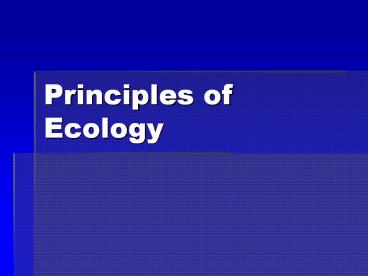Principles of Ecology - PowerPoint PPT Presentation
1 / 44
Title:
Principles of Ecology
Description:
Title: Unit 2 Chapter 2 Principles of Ecology Author: Tehmeena_Qamar Last modified by: e133200 Created Date: 5/28/2004 3:48:45 PM Document presentation format – PowerPoint PPT presentation
Number of Views:342
Avg rating:3.0/5.0
Title: Principles of Ecology
1
Principles of Ecology
2
What is ecology?
- Ecology study of interactions that take place
between organisms and their environment
3
Habitat vs. Niche
- Habitat place where organism lives
- Niche role or position a species has in its
environment
4
Symbiosis interactions between 2 species living
together
- Mutualism both benefits
- Commensalism one benefits, the other unaffected
- Parasitism one benefits, one is harmed
- Predation one benefits, one dies
5
Mutualism
Clownfish is protected, while providing a lure
for the anemone. Some say that this relationship
can be commensalistic.
6
Get food and pollination of flowers!!
7
Commensalism
8
(No Transcript)
9
Parasitism
Head lice
10
(No Transcript)
11
Predation is the interaction between two species
in which one species uses another species as
food.
12
Symbiotic Relationships worksheet!
13
How do organisms obtain energy?
- Autotroph (producer) photosynthetic or
chemosynthetic, makes own food - Heterotroph (consumer) eat other organisms,
cannot make own food
14
Heterotroph?Consumers are not all alike
- Herbivores eat only plants- primary consumers or
1st order consumers - Carnivores eat only animals- secondary, tertiary,
quaternary consumers or 2nd, 3rd, 4th order
consumers - Omnivores eat both plants and animals.
- Detritivores eat dead or decaying organic matter-
scavengers. - Decomposers are detritivores that break down
organic matter into simpler compounds. They
recycle!
15
Autotroph?photosynthesis
16
Heterotrophs - herbivores
- consume only vegetative matter
- mostly primary consumers. Or 1st Order Consumers.
17
Heterotrophs - carnivores
- obtain energy from eating other consumers
- Secondary, tertiary and quaternary consumers
- 2nd, 3rd, 4th Order Consumers
18
Heterotrophs - omnivores
- obtain energy from eating producers and consumers
19
Decomposers
Typical examples fungus and bacteria
20
Heterotrophs Detritivores (scavengers)
- Scavengers feed off of dead or decaying living
things but do not recycle matter back into the
ecosystem
21
(No Transcript)
22
Food chain
- shows how matter and energy move through an
ecosystem (one route)
berries ? mice ? black bear
Starter 26
23
(No Transcript)
24
(No Transcript)
25
Food web
- shows interactions between organisms (all
possible routes) - Contains Multiple Food Chains
26
(No Transcript)
27
(No Transcript)
28
(No Transcript)
29
Food web activity-yarn!
30
1. Label each of the organisms either as
producers, primary, secondary tertiary or
quaternary consumers, carnivores, herbivores and
predators in this food web.
Copy food web in your notebook
2. Analyze the food web and Explain the balance
that is upset when a major predator is removed
from an ecosystem.
31
Deer-wolf population LABwork in class if not
finish it is homework!
32
Use foldable to take notes and add to the side
whatever doesnt fit in the foldable
33
Energy pyramid
Pyramid of Energy
Heat
0.1 Consumers
1 Consumers
Heat
- Shows how much energy is available at each
trophic (energy) level
10 Consumers
Heat
Heat
Parasites, scavengers, and decomposers feed at
each level.
Starter 25
34
Energy Pyramids Show
- As you go up you lose 90 of energy
- Only 10 percent of energy is carried over
35
Energy Pyramid
36
Number pyramid- A pyramid of numbers shows the
numbers of individual organisms at each trophic
level in an ecosystem. A vast number of
producers are required to support even a few top
level consumers
37
38
Biomass pyramid
- Biomass is the total weight of living matter at
each trophic level - Or Biomass is a measure of the total dry mass of
organisms in a given area.
mass
39
(No Transcript)
40
Four cycles in nature
- Water cycle
- Carbon cycle
- Nitrogen cycle
- Phosphorus cycle
41
Water cycle The hydrologic, or water, cycle is
the circular pathway of water on Earth.Organisms
all have bodies made mostly of water
42
Carbon CycleCarbon is the building block of
life.
- The carbon cycle moves carbon from the
atmosphere, through the food web, and back to the
atmosphere. - Carbon is emitted during the burning of fossil
fuels. - Some carbon is stored for long periods of time in
areas called carbon sinks.
43
Nitrogen cycle
The nitrogen cycle mostly takes place underground
- Some bacteria convert gaseous nitrogen into
ammonia through a process called nitrogen
fixation. - Some nitrogen-fixing bacteria live innodules on
theroots of plantsothers livefreely insoil.
44
Nitrogen cycle cont.
- Ammonia released into the soil is transformed
into ammonium. - Nitrifying bacteria change the ammonium into
nitrate. - Nitrogen moves through the foodweb and
returnsto the soil duringdecomposition.































